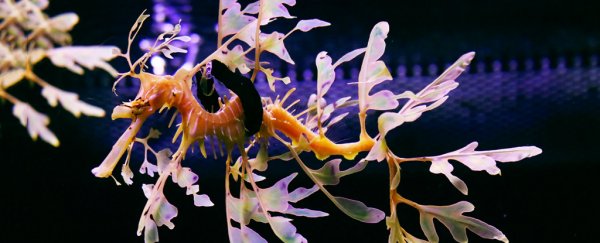Leafy sea dragons, foot-long fish with flowy and fernlike fronds, typically lead what appears to be a very chill existence.
In their native Australian waters, they float with the current, avoiding predators by looking more like stray seaweed than flesh. To fill their bellies, they suck tiny crustaceans off the ocean floor through a columnar snout similar to those of their sea horse relatives.
"They sort of hover like an astronaut," said Ari Fustukjian, a veterinarian at the Florida Aquarium in Tampa.
So Fustukjian and his colleagues knew something was wrong when three leafy sea dragons the aquarium acquired this spring from Australia were sinking.
The juvenile fish, whose sexes still have not been determined, were using all their energy in futile attempts to stay above the floor of their habitat.
They were eating poorly. If something didn't change, Fustukjian said he knew, the trio would die.
X-rays soon revealed that their swim bladders - air sacs in some fish that regulate buoyancy - were "almost absent," Fustukjian said. "Somewhere along the normal developmental process, these guys missed the bus."
That's not terribly unusual in the species, he said, but it was surprising to see it in all three. The good news was that they were otherwise healthy, so finding a way to make them buoyant would solve the problem.
And that's how Fustukjian came up with tiny sea-dragon floaties.
The fixes were black rings that loop around the animals' midsections like life preservers and are made of neoprene, which provides buoyancy, is soft on a sea dragon and can withstand saltwater.
The vet and his team first tried them in June, and they functioned well: The fish were able to float horizontally and to lower their heads to snort little shrimp off the floor of their tank.
Strapping them on was dicey, Fustukjian said, because leafy sea dragons are fragile, and the small suture needed to sew the ring together could threaten their delicate fronds.
But he said over several upgrades and changes - the young fish have grown from about five to nine inches - he has become able to perform a fitting in under a minute. The sea dragons seem unperturbed, he said.
"Literally the second time we put a ring on one of these animals, he immediately went back into the tank and started eating," Fustukjian said.
With their new gear, the leafy sea dragons joined the growing ranks of animals fitted with some sort of prosthetic (though their rings are more assistive devices than ones meant to replace a body part).
At least one miniature horse has gotten an artificial leg. A Pennsylvania parrot has a 3D-printed foot. A Turkish turtle was given a new jaw. Two years ago, a goldfish - also in Pennsylvania - was fitted with braces.
To date, the Florida leafy sea dragon trio has made limited public appearances, but "it's about time for their big reveal," said Eric Hovland, the aquarium's associate curator.
They'll be floating ethereally for all to see, just looking a little bit stranger than they naturally do.
"My first exposure to these was on the pages of Ranger Rick, and it was an animal I couldn't believe existed," said Hovland, who added that visitors often express similar surprise. "They blow their minds."
2018 © The Washington Post
This article was originally published by The Washington Post.
